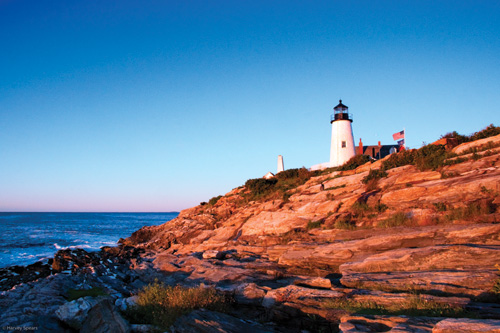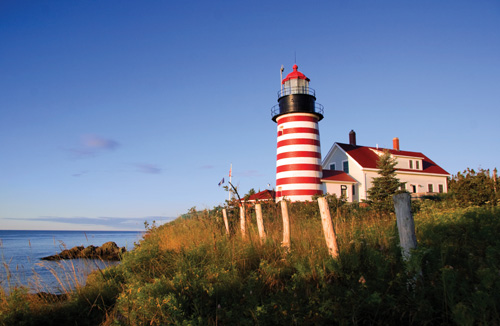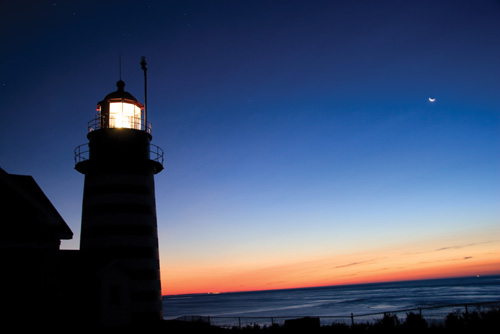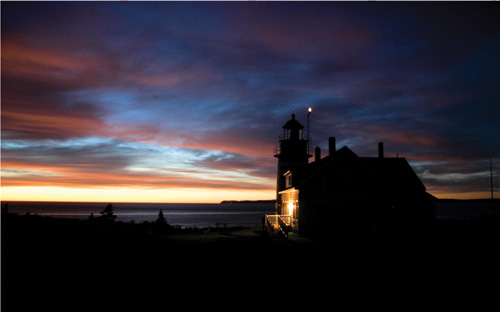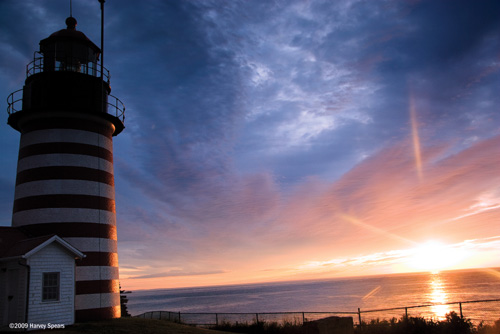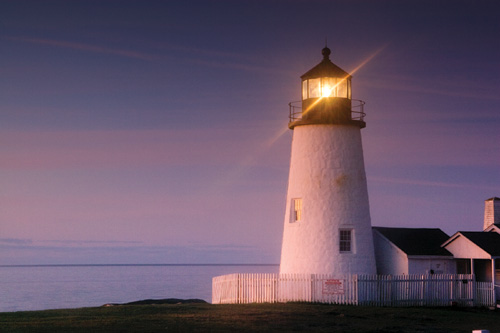 |
|||||
| The Lighthouse News and History Magazine | |||||
|
The Lighthouses of Maine and Ourselves
By Harvey Spears As a photographer who visits Maine often to photograph the spectacular and historic lighthouses, I was excited to learn about the Open Lighthouse Day Event held at the Pemaquid Point Lighthouse Park. Lighthouses, particularly in Maine, have so much meaning for people. From the time of antiquity, lighthouses have captured people's imagination and awe. The Pharos lighthouse in Alexandria, Egypt, built in 290 BC, stood 400 feet tall, and lasted up until 1300 AD. Wow! You get a sense of the achievement of this structure when you consider that the tallest lighthouse in the US today, Cape Hatteras, NC, is 200 feet tall. Lighthouses have been the subjects of much art, including that of artists who loved Maine's rugged coast: Winslow Homer, Edward Hopper, and Andrew Wyeth. We all have been affected by stories of ships that have been saved because of a lighthouse and the heroic efforts of the light keepers and ordinary citizens who risked their lives to save people from maritime disasters. Just being next to one of these great and sometimes humble structures that border the coast of Maine gives you a thrill as you look out onto the waters and landscape beyond. Their history is rich in meaning. However there is a depth of meaning that I had no idea of until I learned from the education of Aesthetic Realism that what a lighthouse does is what we are all trying to do in our lives - put opposites together. "The world, art, and self explain each other; each is the aesthetic oneness of opposites." This principle, stated by the founder of Aesthetic Realism, Eli Siegel, I believe is an invaluable guide to seeing our relation to lighthouses with increasing wonder and meaning. Here are two examples. 1. Pemaquid Point Lighthouse or Pride & Humility One of the first lighthouses that took my breath away was Pemaquid Point in New Harbor, Maine. As I first got a glimpse of this wonderful structure, I was swept by its simplicity and majesty on a rocky promontory overlooking Muscongus Bay.
The Lighthouse, first erected in 1847, while solidly there, also fits in with its surroundings- tall conifers, rocky shore and surf crashing against the coastline. The designers and builders, while knowing of its strategic position of usefulness, were, I believe, also aware of its visual effect. As Mainers proudly know, it was selected to represent the State of Maine on the U.S. quarter. No matter how many times Pemaquid Lighthouse is photographed, year after year, persons return. And a large reason is the way it puts opposites together, including pride and humility. Its simple conical shape, painted white, and only 38 feet high, embodies a kind of modesty. However, there is also pride as it is elevated by the rocky promontory - and you experience both the pride and the modesty as one thing as it faces a wide bay. In my life, pride and modesty often fought. I took "pride" in arrogantly asserting my opinions, insisting that my way was the only way, including with women. And then I felt ashamed and tried to make up for my arrogance by acting humble, contrite. The Pemaquid Light stands for a true relation of pride and humility. To achieve this, we need to have a purpose that is fair to the world: to see meaning in other people and things. This, I learned, is also the purpose of art. 2. West Quoddy Head Light or Meaning is Looked For First commissioned by Thomas Jefferson in 1808, West Quoddy Head Light is one of Maine's earliest lighthouses. It is the most eastern lighthouse in the USA, located in Lubec, overlooking The Bay of Fundy. From the moment I learned of it and saw those wonderful bold red and white bands, which are both assertive and calming at once, going from top to bottom - with a touch of humor - I knew I had to be there.
However I had no idea how spectacular and moving an experience it would be. As a photographer, I looked forward to photographing where the sun first touches our country with its loving rays: in Washington County, also known as the "Sunrise Country". The Passamaquoddy Indians, who were the original settlers of this area, are known as "The People of the Dawn". I am glad that their descendents are still there. I photographed sunrises at other locations, but this was something I wasn't prepared for.
The combination of sun, lighthouse and ocean in this part of our country is an organic trio that can make for great emotion. No two sunrises are exactly alike. You never know what kind of sunrise awaits you, and this is part of the drama.
And each time, the relation of opposites, including light and dark, is different and brings out a different quality in the lighthouse and makes for big new feelings in the viewer.
There are charm and mystery, and a person has a sense of kinship to a wide universe that is both known and unknown. Seeing this trio of lighthouse, sun and ocean, I felt I can be in an ever increasingly deep and useful relation to other things. The lighthouse is central in having this meaning be felt. I remember at one sunrise I met a couple from Augusta, Maine, who told me they come here often just to experience this, and they felt closer to each other afterwards. In a lecture he gave in 1971, entitled, "Imagination Shows Meaning," Mr. Siegel commented on lighthouses. He said: "A large thing in meaning is to have something definite accompanied by vagueness. The first thing is the relation of the lonely center to the radii of the circumference. The idea of a lighthouse in an ocean is related to center and circumference. Something surrounded by something different." We can feel that we are the "center" of the universe and see ourselves as distant from the meaning of other people and things. This, as I know from my own life, makes a person lonely. A lighthouse, however, doesn't do this.
What is vague and distant-a ship on the horizon-is brought closer by a steady beam of light that goes out. That beam of light, going from a point and radiating over an expanse of ocean, affirms relation. Seeing this is one of the most thrilling and reassuring experiences a person can have, and the reason for this, as Aesthetic Realism shows, is that this is what we hope to do. I have seen that knowing the lighthouses of Maine can have make a person's life better, and I'm looking forward to photographing each of the 60 plus Lighthouses of Maine! Harvey Spears is a photographer/writer/art director who is from Maine and New York and loves photographing in Maine. His work has appeared on the State of Maine website including the Department of Inland Fisheries and Wildlife magazine. His work has also appeared in photographic exhibitions at the Terrain Gallery, NYC and in newspapers and photographic journals. You can call him at 212-533-6275 or e-mail him at redmonkey2@mac.com. To learn more about his work, you can also visit his website at www.harveyspears.com. For more information about Aesthetic Realism, go to www.aestheticrealism.org. If you are not a subscriber, please subscribe today. Click here. |


